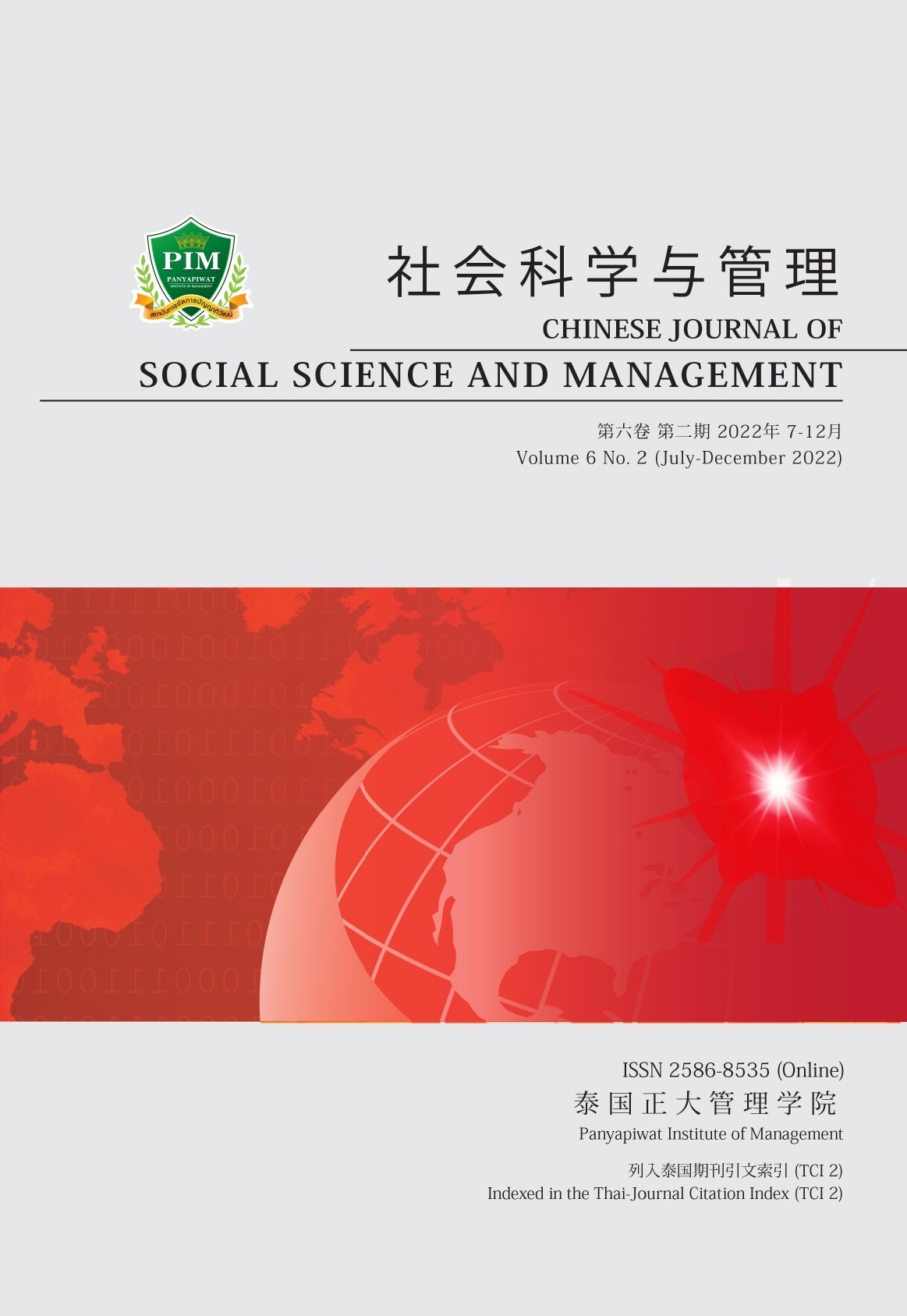基于求新动机调节作用下的消费者善意与重游意愿的关系研究 ——以中国赴泰旅游者为例
##plugins.themes.bootstrap3.article.main##
摘要
现有的关于重游意愿的研究主要集中于本国内的重游意愿的研究上,只有少数学者研究了跨国重游意愿,且鲜有学者将消费者善意作为重游意愿的影响因素进行研究。本文基于依恋理论和认知-情感-行为(意愿)关系理论,构建了消费者善意、旅游满意度和重游意愿的关系模型,并探讨了求新动机对消费者善意和旅游满意度之间的调节作用,本研究以有过泰国旅游经历的中国公民为研究对象,以泰国为目标善意国,采用问卷调查法收集数据,应用多层回归分析处理数据。研究发现,文化善意、景观善意和人民善意对重游意愿有显著的正向影响,旅游
满意度在文化善意、景观善意和人民善意与重游意愿之间起部分中介作用,求新动机负向调节人民善意和旅游满意度之间的关系。本文研究的结论在对泰国以及其他国家对中国公民的旅游宣传有一定实践指导意义,在对游客出国重游行为的影响因素研究上提供了新的研究思路。
##plugins.themes.bootstrap3.article.details##
Chinese Journal of Social Science and Management Editorial Division
The Office of Research and Development, Panyapiwat Institute of Management
85/1 Moo 2, Chaengwattana Rd., Bang Talat, Pakkred, Nonthaburi 11120, Thailand
Tel. 02 855 01048 E-mail: cjssm@pim.ac.th
参考
Assaker, G., Vinzi, V. E., O’Connor, P., Management, T., & Ryan, C. (2011). Examining the effect of novelty seeking, satisfaction, and destination image on tourists’ return pattern: A two factor, non-linear latent growth model. Tourism Management, 32(4), 890-901.
Asseraf, Y., & Shoham, A. (2016). Destination branding: The role of consumer affinity. Journal of Destination Marketing & Management, 6(4), 375-384.
Baker, D. A., & Crompton, J. L. (2000). Quality, satisfaction, and behavioral intentions. Annals of Tourism Research, 27(3), 785-804.
Bernard, Y., & Zarrouk-Karoui, S. (2014). Reinforcing willingness to buy and to pay due to consumer affi nity towards a foreign country. International Management Review, 10(2), 57-67.
Cohen, E. (1979). Rethinking the sociology of tourism. Annals of Tourism Research, 6(1), 18-35.
Goodrich, J. N. (2000). Tourism: Principles, practices, philosophies. Journal of Travel Research, 39(1), 114-115.
Guo, G. X., & Zhou, X. (2016). A literature review of consumer affinity and prospects. Foreign Economics & Management, 38(1), 64-71. [in Chinese]
Guo, Y. Z., Zhang, H., Song, S. L., Li, L., Chen, X. L., & Zhang, L. (2004). A study of market positioning of China’s outbound travel destinations. Tourism Tribune, 19(4), 27-32. [in Chinese]
Gyte, D. M., & Phelps, A. (1989). Patterns of destination repeat business: British tourists in Mallorca, Spain. Journal of Travel Research, 28(1), 24-28.
Huang, S., & Hsu, C. H. (2009). Effects of travel motivation, past experience, perceived constraint, and attitude on revisit intention. Journal of Travel Research, 48(1), 29-44.
Jang, S. S., & Feng, R. (2007). Temporal destination revisit intention: The effects of novelty seeking and satisfaction. Tourism Management, 28(2), 580-590.
Keaveney, S. M. (1995). Customer switching behavior in service industries: An exploratory study. Journal of Marketing, 59(2), 71-82.
Kim, H., Woo, E., & Uysal, M. (2015). Tourism experience and quality of life among elderly tourists. Tourism Management, 46, 465-476.
Kim, S., & Kim, H. (2015). Moderating effects of tourists’ novelty-seeking tendencies on the relationship between satisfaction and behavioral intention. Tourism Analysis, 20(5), 511-522.
Kozak, M., & Rimmington, M. (2000). Tourist satisfaction with Mallorca, Spain, as an off-season holiday destination. Journal of Travel Research, 38(3), 260-269.
Kozak, M. (2001). Repeaters’ behavior at two distinct destinations. Annals of Tourism Research, 28(3), 784-807.
Lee, T. H., & Crompton, J. (1992). Measuring novelty seeking in tourism. Annals of Tourism Research, 19(4), 732-751.
Liu, F. J., Xu, J. Y., & Wu, N. (2019). A research on the factors influencing tourists’ revisit willingness based on a meta-analysis. Tourism Science, 33(1), 33-53. [in Chinese]
Mao, X. G., & Song, J. P. (2011). A study on relationship between tourist’s motivation and revisitation intention: Based on logistic model. Human Geography, 26(6), 149-154. [in Chinese]
Nes, E. B., Yelkur, R., & Silkoset, R. (2014). Consumer affinity for foreign countries: Construct development, buying behavior consequences and animosity contrasts. International Business Review, 23(4), 774-784.
Oberecker, E. M., & Diamantopoulos, A. (2011). Consumers’ emotional bonds with foreign countries: Does consumer affinity affect behavioral intentions? Journal of International Marketing, 19(2), 45-72.
Oberecker, E. M., Riefler, P., & Diamantopoulos, A. (2008). The consumer affinity construct: Conceptualization, qualitative investigation, and research agenda. Journal of International Marketing, 16(3), 23-56.
Oppermann, M. (1998). Destination threshold potential and the law of repeat visitation. Journal of Travel Research, 37(2), 131-137.
Pan, Y., Gao, L., Zhang, X., & Wan, Y. (2014). A study on customer value under Chinese culture background: Scale’s development and comparison. Management World, (4), 96-112. [in Chinese]
Pizam, A. (1978). Tourism’s impacts: The social costs to the destination community as perceived by its residents. Journal of Travel Research, 16(4), 8-12.
Pratminingsih, S. A., Rudatin, C. L., & Rimenta, T. (2014). Roles of motivation and destination image in predicting tourist revisit intention: A case of Bandung-Indonesia. International Journal of Innovation, Management and Technology, 5(1), 19-24.
Prayag, G., & Ryan, C. (2012). Antecedents of tourists’ loyalty to Mauritius: The role and influence of destination image, place attachment, personal involvement, and satisfaction. Journal of Travel Research, 51(3), 342-356.
Shoemaker, S., & Lewis, R. C. (1999). Customer loyalty: The future of hospitality marketing. International Journal of Hospitality Management, 18(4), 360-370.
Solomon, M. R. (2015). Consumer behavior: Buying, having, and being. Pearson Education.
Song, H., Van der Veen, R., Li, G., & Chen, J. L. (2012). The Hong Kong tourist satisfaction index. Annals of Tourism Research, 39(1), 459-479.
Thomson, M. (2006). Human brands: Investigating antecedents to consumers’ strong attachments to celebrities. Journal of Marketing, 70(3), 104-119.
Wongtada, N., Rice, G., & Bandyopadhyay, S. K. (2012). Developing and validating affinity: A new scale to measure consumer affinity toward foreign countries. Journal of International Consumer Marketing, 24(3), 147-167.
Xu, C. X., & Zhu, X. (2011). The effect of novelty seeking and satisfaction on temporal revisit intention: A case study of Ancient Fenghuang Town in Hunan. Tourism Science, 25(5), 57-66. [in Chinese]
Yang, Y. W., Sun, G. H., & Tong, Z. L. (2018). The impact mechanism of consumer animosity, affinity and ambivalence on consumers’ outbound travel intentions: The moderating effects of culture proximity. Journal of Central University of Finance & Economics, 37(6), 94-105. [in Chinese]
Yuksel, A., Yuksel, F., & Bilim, Y. (2010). Destination attachment: Effects on customer satisfaction and cognitive, affective and conative loyalty. Tourism Management, 31(2), 274-284.


